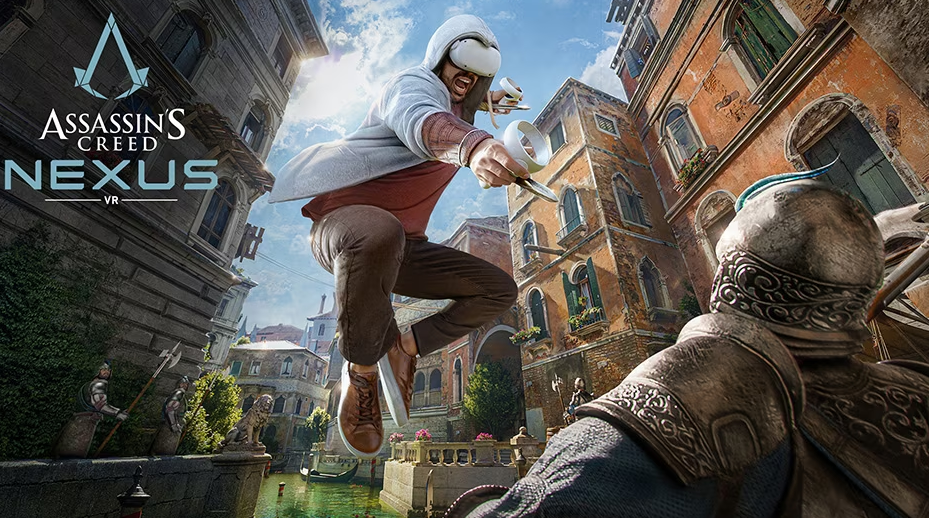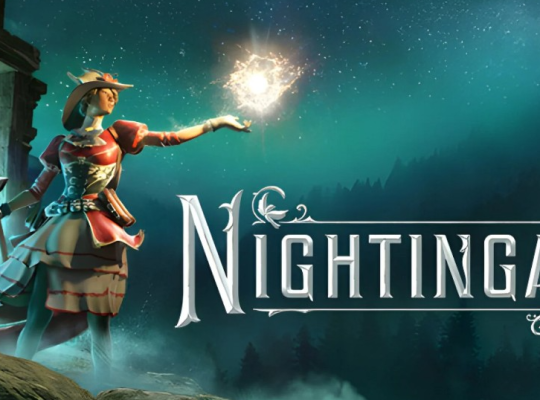Assassin’s Creed Nexus serves as a virtual reality compilation of the series’ highlights, placing an unsuspecting hacker in control of the memories of three iconic characters: Ezio from Assassin’s Creed II, Connor from Assassin’s Creed III, and Kassandra from Assassin’s Creed: Odyssey. The central plot involves Abstergo’s quest for world domination through an otherworldly MacGuffin, activated by information scattered within these memories—a typical theme in the Assassin’s Creed universe. The game features an exceptional portrayal of the villain by Morena Baccarin, renowned for her roles in Gotham, Deadpool, and Firefly.
In the transition to VR on Meta Quest 2, 3, or Pro, Assassin’s Creed Nexus introduces parkour-style movement, intense jumps, and combat, including iconic actions like running, jumping, stabbing, and killing. Despite initial concerns about the potential discomfort of VR parkour and high falls, Ubisoft successfully navigates these challenges, maintaining a comfortable experience even during extended play sessions.
Unlike the usual open-world design of Assassin’s Creed games, Assassin’s Creed Nexus opts for a predominantly linear experience. However, it occasionally allows players to explore enclosed areas with additional parkour challenges. Players can freely explore these zones before reaching a “point of no return.” This design choice, considering the nature of VR gaming, proves to be a smart decision. It provides more freedom than many virtual reality titles while incorporating comfort settings, ensuring players are not overwhelmed by the pursuit of crafting materials or other superfluous elements during extended gameplay sessions.
The Setup: Infiltrating Abstergo’s Nexus in Assassin’s Creed Nexus
As the hacker working for the Brotherhood, your mission is to infiltrate Abstergo’s latest venture, the Nexus. Throughout sixteen missions, you’ll delve into the memories of Ezio from the Assassin’s Creed 2 trilogy, Kassandra from Odyssey, and Connor from Assassin’s Creed III. While Ezio and Kassandra prove to be captivating protagonists, Connor’s narrative is less engaging, yet his American Revolution setting remains intriguing. Abstergo’s pursuit of the Antikythera, fueled by the allure of Archimedes’ device, forms the crux of the narrative.
Following well-acted cutscenes, you’ll step into Ezio’s memories, encountering a notable discrepancy in the quality of acting among side and ancillary characters. This stands out as a notable aspect of Nexus. Although the game feels like a genuine Assassin’s Creed installment, the mismatched NPC accents occasionally resemble those from a poorly executed school play.
This inconsistency contrasts sharply with the visually impressive presentation of the new Meta Quest 3. While I initially played on Quest 2, which appeared rough but ran smoothly, the significant leap in graphical quality on Quest 3 was evident. Unfortunately, I did not have the opportunity to test the Quest Pro.
Throughout the game’s seventeen GB install, you’ll explore various locations in Italy, Ancient Greece, and Revolutionary America. NPC variety is limited, and asset reuse is evident to manage the game’s file size. Despite commendable efforts on the Quest 2, noticeable cutbacks in settings result in prominent pop-in issues. The Quest 3, with its improved passthrough cameras, provides a more enjoyable experience, although both headsets suffer from inadequate basic head straps. I opted to replace the Quest 3’s knock-off with a third-party knock-off elite strap from Amazon for $30.
Before each mission, brief cutscenes featuring Dominika, your Abstergo contact, set the stage. The entire interaction takes place in the metaverse, emphasizing the game’s immersion in virtual reality. Occasionally, you’ll converse with returning Brotherhood members Sean and Rebecca, with basic yet enjoyable puzzles to access their communications. While the game’s challenges are not mentally taxing, the emphasis is on enjoyment, allowing players to feel like formidable assassins throughout their gaming experience.

Assassin’s Creed Nexus Gameplay Experience: Navigating the Virtual World
Given the nature of being a VR parkour fighting game, initial apprehension about potential motion sickness during gameplay was inevitable. However, the experience proved surprisingly comfortable, particularly in shorter sessions of around 30 minutes. Extended play sessions of an hour or more, undertaken to meet embargo requirements, did result in fatigue and slight dizziness. The choice of a proper head strap significantly contributed to reducing discomfort, highlighting the game’s compelling and enjoyable nature that urged me to play continuously.
The controls are both simple and intuitive, enhancing the overall gameplay. Activating the hidden blade involves holding the trigger for the selected hand (limited to the left for Kassandra) and flicking the wrist forward. Jumping is assigned to the A button, and when the blade is deployed, executing a jump from significant heights offers a visually satisfying slow-motion descent, culminating in a precise stabbing motion. This visceral action became a standout and favorite element of the game.
While melee combat is serviceable, it lacks the physics-based fluidity seen in the best VR brawlers. The combat system has a specific setup for parrying and attacking, occasionally feeling somewhat robotic. Attempts to prevent spamming are evident, with enemies pushing back when relentlessly attacked. Ranged combat, on the other hand, shines with each character equipped with a unique ranged weapon—Kassandra and Connor with bows, and Ezio with a crossbow. Smoke bombs and throwing knives add versatility, with remarkably accurate ranged attacks contributing to the overall satisfaction of gameplay.
The game’s movement mechanics, coupled with the ability to seamlessly jump towards any targeted point while running, elevate it to an ideal stealth experience. Climbing structures are facilitated by an infinite grip strength, emphasizing the game’s commitment to fun. The three available difficulty settings allow players to tailor the challenge level to their preference, with the default setting offering a forgiving experience that can be adjusted for a more substantial challenge.
Overall Assessment of Assassin’s Creed Nexus:
Assassin’s Creed Nexus excels in nearly every aspect, except its narrative. While not inherently flawed, the story is merely “fine.” The writing is decent, and the voice acting is mostly solid, but the constant shifts in settings make the narrative feel meta-story disjointed. The meta-story concludes on a somewhat unsatisfying note. Although it never reaches a level of poor quality, the narrative falls short when compared to the typically strong storytelling found in Assassin’s Creed games.
The various settings in the game are well-crafted, offering sufficient variety to prevent any sense of staleness. Each location provides opportunities for completing challenges, finding items, and achieving a 100% completion rate. Parkour challenges, shooting galleries, and synchronization points contribute to the incentive for revisiting each level. Synchronization points, in particular, offer a unique perspective, allowing players to view each level from a bird’s eye angle, tag enemies, and identify hidden treasures.
While certain aspects of the voice acting and overall plot may fall short, the music in Assassin’s Creed Nexus stands out as excellent, a characteristic trait of the franchise. The themes of all three protagonists are seamlessly woven into their respective levels, complemented by a main title song that feels both fresh and familiar. Assassin’s Creed Nexus Despite the game’s immersive nature in VR, encounters with bugs were minimal, primarily limited to brief moments of getting stuck in the environment. Although not major, such instances can disrupt the VR experience and induce discomfort.

Reviving Assassin’s Creed: A VR Journey with Nexus
Background Critique: As a critic who believes the Assassin’s Creed series peaked with its second installment, I’ve been skeptical about the subsequent releases, feeling that Ubisoft veered away from an epic, overarching narrative in favor of popular settings. While some sequels stood out as good or even excellent games, such as Black Flag, recent entries have been criticized for repetitive grind and uninspired quest design.
Ubisoft Red Storm’s Redemption: Ubisoft Red Storm’s delivery of Assassin’s Creed Nexus marks a triumphant return to the series’ glory days, seamlessly blending gameplay and story in a unique and captivating way. Venturing into VR, I step into the shoes of Ezio Auditore da Firenze, revisiting Monteriggioni.
Assassin’s Creed Nexus Despite not playing Assassin’s Creed 2 for a decade, the experience feels like a homecoming, with the city exuding a familiar aura as if I never left. The emotional resonance is undeniable, stirring the inner nerd within me.
Diverse Historical Leaps: Avoiding spoilers, the game lets me embody not only Ezio but also Cassandra (Assassin’s Creed Odyssey) and Connor (Assassin’s Creed 3), facilitating historical leaps that inject visual variety into the narrative. These jumps across time contribute to the richness of the experience, especially for long-time Assassin’s Creed enthusiasts.
Innovative Immersion through Mixed Reality: Ubisoft Red Storm introduces a clever immersive technique using Mixed Reality to intertwine the present-day hacker story. Suddenly finding myself in my room with a digital 3D menu of a communication panel, I’m connected to fellow members of the Brotherhood. The switch to Mixed Reality blurs the lines between the game and reality, reinforcing the notion that I am the hacker, adding authenticity. Subtle details, like virtual contacts in VR removing their headsets, further enhance the sense of immersion.
VR as a Narrative Medium: The developers showcase their understanding of VR as a narrative medium, going beyond traditional storytelling. They prove that VR is not just about words; it’s about creating a credible and immersive experience through thoughtful details and a deep understanding of the medium’s unique facets. Ubisoft Red Storm’s execution with Nexus brings renewed hope for the future of the Assassin’s Creed franchise.
Assassin’s Creed Nexus Elevates Quest 3 to Triple-A Status in VR
VR Graphics and Open World Innovation: Having experienced various VR games, I’ve witnessed the potential developers can unlock with limited resources, especially when they grasp the intricacies of the medium. Games like Red Matter 2 showcase impressive graphics on Quest 2, further enhanced on Quest 3 due to the XR headset’s increased power. However, such VR games typically unfold in relatively confined spaces optimized for the headset’s capabilities.
Shaping the Open World on Mobile VR: In the realm of mobile VR, Assassin’s Creed Nexus stands out by redefining open-world possibilities. While the areas are still constrained, they surpass the scope of most standalone VR experiences. The game extends my virtual body seamlessly to accommodate actions like crouching or climbing along walls. Standing atop rooftops in bustling cityscapes, such as Venice, offers breathtaking views with meticulously detailed environments, showcasing reflections, intricate objects, and finely crafted weapons.
Innovative Animus Scout and Detailed NPCs: The Animus Scout feature provides a bird’s-eye view of the city, a perspective appreciated by tabletop enthusiasts like myself. The NPCs, even up close, are impressively detailed and well-animated, contributing to creating a believable, living world. The in-game citizens add a layer of realism, making it possible to walk into a virtual Venice piazza bustling with people—an unexpected feat for a mobile VR headset.
Expansive Areas and Seamless Graphics Streaming: The playable areas in the game are not just large but at times, huge. From Monteriggioni to Venice, Assassin’s Creed Nexus the environments offer exploration both horizontally and vertically. The swift movement across rooftops showcases a seamless graphics streaming system, subtly managing the load and seamlessly introducing elements into the scene.
While the Quest 3’s limitations are acknowledged, particularly with close-range blurred 2D textures, the developers strategically balance high detail for crucial elements with lower detail or 2D textures for peripheral areas, demonstrating a mastery of VR development.
A Masterpiece of VR Development: Assassin’s Creed Nexus, optimized for the Quest 3, emerges as a masterpiece in VR development, pushing the boundaries of what’s achievable on a mobile VR platform. Assassin’s Creed Nexus The game not only leverages Quest 3’s enhanced power but also demonstrates a thoughtful approach to graphics, world-building, and immersion, cementing its status as a Triple-A title in the VR realm.
Assassin’s Creed Nexus VR: A Ballet of Lethal Elegance
Exquisite Assassinations: When I find myself crouching on a roof virtually, unleashing the virtually hidden blade with a flick of my real wrist, descending upon my victim in slow motion, and forcefully plunging the blade into their body, Assassin’s Creed Nexus propels the art of assassination to a new pinnacle. This method, my favorite, remains endlessly captivating and never loses its allure.
Versatile Ranged Combat: Engaging enemies at a distance, I seamlessly transition between a bow and a crossbow, employing realistic hand movements to load both becamens. Throwing daggers became my life init surf rope, swiftly hurled from my chest and hurled at opponents to stifle potential alarms. However, in the melee against elites or bosses, the combat system’s flaws become apparent.
Assassin’s Creed Nexus Frantic weapon wielding and the ease with which enemies block attacks lead to occasional frustration and multiple restarts. The timing for blocking, parrying, and counter-attacks is crucial, and failure results in swift demise.
Challenges in Melee and Climbing: Forced into melee or fleeing, climbing can become a precarious venture. Mistimed attempts or failures in the rush expose vulnerabilities, making it easy for guards to shoot me off the wall like targets in a shooting gallery. Melee combat may prove challenging, particularly for occasional VR players, with some encounters testing controls and player competence.
Strategic Stealth and Ingenious Maneuvers: Sneaking past enemies or strategically eliminating them silently emerges as the preferred approach. Noteworthy moments include extracting arrows and throwing daggers from fallen foes, concealing corpses in haystacks, or disposing of them in the harbor. A highlight involves confronting a heavily armored soldier on a tower.
Assassin’s Creed Nexus Unable to pierce his defenses with a throwing dagger, I observed his patrol route, strategically positioned myself, and, with a satisfying maneuver, sent him over the edge—an exhilarating feat, albeit with the caveat of remembering to hold on tight.
A Symphony of Satisfaction: Assassin’s Creed Nexus VR transforms combat into a symphony of lethal elegance, where each move is a choreographed dance of death. The flaws in melee combat are evident, yet the game’s immersive and strategic elements contribute to an overall satisfying experience that transcends occasional frustrations.
Comfort and Critique in Assassin’s Creed Nexus VR
Comfort Features for Varied Preferences: Fortunately, motion sickness isn’t a concern for me, enabling a seamless experience with smooth movement in the game. This aspect, especially evident during parkour sequences and daring rooftop escapes, amplifies the game’s enjoyment for those who can handle it.
Recognizing diverse player preferences, Ubisoft Red Storm incorporates extensive comfort settings. Players can opt for teleportation, automated parkour completion, grid lines for vertigo mitigation, and customizable turning options, catering to a wide range of comfort preferences. The inclusivity of these features sets a commendable standard.
Impressive Development with Minimal Bugs: The development team behind Assassin’s Creed Nexus has executed an impressive job overall, with minimal bugs encountered during gameplay. Instances of the sound disappearing or encountering issues with item interaction occurred infrequently.
Assassin’s Creed Nexus Notable bugs included a situation where picking up a key was only possible after eliminating an unrelated guard and another where a freshly stabbed corpse exhibited an unexpected, bouncy trajectory. These occurrences, while present, were rare and did not significantly detract from the overall gameplay experience.
Minor Animation and NPC Details: While the game excels in various aspects, some fine-tuning in animations and NPC details is warranted. Certain elements in these aspects could benefit from additional polish. Nevertheless, considering the overall quality of the game, these minor imperfections remain at a relatively high level of complaint. The developers’ attention to detail in other areas mitigates the impact of these animation and NPC nuances on the overall gaming experience.
Hidden Blades in VR: Crafting an Immersive Assassin’s Creed Experience
Perfectly Suited Transition to VR: The Assassin’s Creed universe, with its rich history of tower-scaling, combat, and parkour, seamlessly lends itself to a virtual reality (VR) adaptation. Assassin’s Creed Nexus Since the inception of the first Assassin’s Creed game in 2007, gamers have been engrossed in navigating ancient landscapes, and the decision to transpose these core elements into a first-person VR experience appears to be a natural and promising progression.
Seamless Immersion in the Virtual World: Upon entering the virtual realm, the immersive quality of the experience becomes immediately apparent. The virtual environment encourages exploration, offering a plethora of walls to climb and balconies to traverse. The Meta Quest 3 controllers, in use for this VR iteration, closely mirror the controls on other platforms such as the PS5.
Movement is facilitated by the left joystick, while the right joystick allows for panoramic views, and interactions are managed using the right and left triggers. The hidden blade, cleverly concealed on the inner forearm, is unsheathed with a satisfying, Spider-Man-esque flick of the wrist.
Thoughtful Customization and Nausea Mitigation: The game boasts an array of settings aimed at enhancing the overall experience and, notably, minimizing potential nausea. Assassin’s Creed Nexus The meticulous attention to detail is evident, with customizable options ranging from basic settings like snap turning and teleportation to features addressing specific concerns. For those with acrophobia, settings are available to aid in overcoming the fear of heights.

Additionally, the option to have a virtual nose as an in-game focal point is a creative touch. The inclusion of time alerts at intervals—15, 30, 45, and 1 hour—serves as a useful feature, reminding players to take breaks and addressing the need for motion sickness mitigation, a topic to be discussed further.
Medieval Metallica: Immersive Experiences and VR Challenges in Assassin’s Creed Nexus
Narrative as an Immersive Journey: Assassin’s Creed Nexus, much like many VR titles, leans more towards providing an experience rather than following a conventional narrative game structure. Assassin’s Creed Nexus The storyline guides players to the most captivating and immersive VR moments, creating a unique and enthralling gameplay dynamic. Whether navigating the canals of Venice after dispatching guards or embodying a Greek soldier in the streets, the game offers moments that feel genuinely satisfying.
Interactions like hurling wine glute-like shredding a lute-like medieval Metallica add an extra layer of enjoyment. The arsenal of weapons, from swords to tomahawks and bows, provides diverse and tempting options, with the constant allure of impulsively interacting with the game world.
Varied Gameplay and Exploration: While the stealth elements can be somewhat repetitive, the overall gameplay rarely becomes tedious. The true joy lies in exploration, a hallmark of the Assassin’s Creed series. However, one significant hurdle hinders the gameplay experience.
The Challenge of Motion Sickness: Assassin’s Creed Nexus introduces a very real challenge in the form of motion sickness, difficult to overlook. To Ubisoft’s credit, the game actively encourages regular breaks and incorporates numerous settings to alleviate the discomfort. Assassin’s Creed Nexus Despite attempting various setting adjustments, motion sickness persists, particularly during close combat encounters.
Scaling buildings becomes a disorienting experience, with sudden turns inducing discomfort. Even the iconic leap of faith, a trademark ability in the game, transforms into a disconcerting plunge into a vortex of hay and horse manure. The struggle with motion sickness can lead to a need for breaks after as little as 20 minutes of gameplay.
Balancing Immersion with Challenges: The impact of motion sickness on gameplay enjoyment becomes a subjective matter, contingent on one’s VR experience and stomach resilience. While the allure of the immersive medieval world beckons exploration, the challenge posed by motion sickness may determine the player’s ability to fully engage with the game.
Also See – Football Manager 2024 Review – FM24 Championship Game.
Assassin’s Creed Nexus in VR: Blending Series Essence with Virtual Reality Brilliance
A Triple-A Experience in VR: Assassin’s Creed Nexus successfully translates the movement and combat dynamics of the beloved series into the immersive realm of virtual reality playable on Quest 2, the game truly shines within the Meta Quest 3, delivering a visually stunning experience that closely rivals a Triple-A release. In an era saturated with Assassin’s Creed titles, this VR entry stands out, leaving players hopeful for more ventures into the virtual reality domain.
A Genuine VR Triumph: Ubisoft could have taken the easy route by delivering a standard VR adaptation of Assassin’s Creed, but Assassin’s Creed Nexus deserves credit for offering an original, captivating, and, most importantly, highly entertaining experience for VR enthusiasts. The game not only captures the essence of the series but also elevates it to new heights within the VR landscape.
Thrills Amidst Narrative Limitations: While the narrative might not be the game’s strong suit, the sheer thrill of wreaking havoc in ancient worlds compensates for any storytelling shortcomings. The engaging and entertaining nature of the gameplay ensures a memorable experience, with the caveat of potentially inducing discomfort for players with full stomachs due to the immersive VR environment.
A Hopeful Future for VR Assassin’s Creed: Assassin’s Creed Nexus marks a notable success in the marriage of series traditions with the immersive potential of virtual reality. The game’s excellence opens the door to possibilities, leaving fans eager for more VR adaptations that continue to push the boundaries of the Assassin’s Creed universe.

















